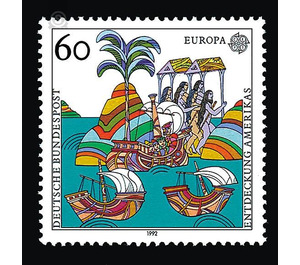europe: 500th anniversary of the discovery of america - Germany / Federal Republic of Germany 1992 - 60 Pfennig
Theme: Post & Philately
| Country | Germany / Federal Republic of Germany |
| Issue Date | 1992 |
| Face Value | 60.00 |
| Color | multi-colored white |
| Perforation | K 13 3/4 |
| Printing Type | Multicolor offset printing |
| Stamp Type | Postage stamp |
| Item Type | Stamp |
| Chronological Issue Number | 1481 |
| Chronological Chapter | GER-BRD |
| SID | 587086 |
| In 63 Wishlists | |
Unlike the first contacts of the Vikings with North America at the turn of the millennium, the discoveries of the fifteenth century, especially that of Christopher Columbus 500 years ago, broke through the closed cycle of the European Middle Ages: a new era arose in the triad of discovery, conquest and exploration finally had the Europeanization of the world in the wake. The conclusion of the Reconquista, the reconquest of the Pyrenees Peninsula by the Arabs, played an important role in the expansion of Portugal and Spain overseas. The Iberian adventurers, shaped by centuries of crusading and conquering thinking, sought new challenges, not least in response to the centralization of state power in their home country. Discovery and conquest went hand in hand with her. Thus, even the son of a simple Genoese weaver, born in 1451, Columbus, the businessman born of social mobility (finally successful), raised the exorbitant demand to become a hereditary viceroy and governor-general of the acquired overseas territories with profit-sharing. The main motive of the discovery voyages, hinting at it, was always the quest for spices and gold in addition to constantly resonating missionary impulses. The monopolization of the Oriental trade by the Turks, especially after the fall of Constantinople in 1453, to which the Europeans, apart from the scarce gold, could not offer much as a means of payment, forced the search for new merchandise and precious metals. Gold was not only for Columbus a mythical attraction, was considered a power and value creating. It was assumed that gold, which had flowed east for centuries, had not remained in the hands of the Arab middlemen, but had gathered in the faraway Asian "India." To the east of it lay, according to the world view of the time, which went back to the Greek Ptolemy (around 150 BC) and the travel portraits of Marco Polo, "Cathay" (China) and the fabulously rich island "Zipangu" (Japan). The fact that it was possible, due to the spherical shape of the earth, to sail there on a western course, was scarcely doubted in the reception of ancient traditions and Arabic science. Representing a widespread school of contemporary geography, Columbus underestimated the length of this route to Asia, so that, unlike the Portuguese, he considered it shorter than the eastern route around Africa. When they were able to sail around the Cape of Good Hope with Bartolomeu Diaz in 1487/88, their King John II finally lost interest in Columbus' plans. After the Granada's fall in 1492, the reign of Spain, Isabella of Castile and Ferdinand of Aragon, granted them the necessary state support. On August 3, 1492, Columbus was able to set sail from Palos, Spain. The nautical conditions for his expedition came mainly from the experience in the Mediterranean ago: With the Rah- and Latin-retired, controlled by Heckruder caravel stood for the first time an Atlantic-suited ship. Columbus's fleet consisted of two such ships, the "Nina" and the "Pinta," and a larger, heavy-duty car as a cargo ship, the "Santa Maria." Introduced in 1480 by the Portuguese astronomical navigation and the usual since the mid-15th century use of the compass known since about 1100 in Europe made possible in cooperation with the refinement of cartography orientation on the high seas. On October 12, 1492, on the 47th day after leaving the Canary Islands, at two o'clock in the morning, sailor Rodrigo de Trina sighted land from the ahead-sailing "Pinta." The island, which the pious Columbus gave the name "San Salvador" (the Redeemer), belonged to the group of today's Bahamas. The first contact with the aborigines was still peaceful: they saw in the newcomers white gods, and Columbus was at first only about discovery, not yet about the conquest and colonization of "West India" and the enslavement of the "Indians," as he probably did consciously called land and people to emphasize his success. Although Columbus remained convinced until his death in 1506 that he had discovered the extreme of Asia with the Chinese province of Mangi, experts soon doubted this. For the first time in 1502, the Florentine navigator Amerigo Vespucci gained the impression of encountering a "Mundus Novus". His so-called travelogue in 1507 led the German geographers Martin Waldseemüller and Mathias Ringmann to propose the name "America" for the New World. (Text: Dr. Christoph Studt, History Department of the Rheinische Friedrich-Wilhelms-Universität Bonn)


